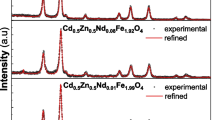Abstract
This study has characterised the oxidation products of a fine-grained single domain magnetite which was made synthetically by a colloidal method. Changes in the intrinsic magnetic properties (saturation magnetisation, saturation remanence, and coercive force) during progressive oxidation are correlated with lattice parameter changes and an oxidation mechanism. It is proposed that magnetite oxidises to hematite via at least two metastable maghemites. The first of these, formed on low temperature oxidation by the formation of a magnetite/maghemite solid solution, is a face centered maghemite with lattice parameter a= 8.3419±0.0006 Å. A second maghemite, produced on oxidation at higher temperatures, has a primitive cubic structure and a lattice parameter a = 8.3505±0.0005 Å. Maghemite cation distributions are derived to explain the reduced saturation magnetisations of between 56 and 74 Am2 kg-1 observed, and a maghemite structure containing an increase in tetrahedral Fe3+ ions and up to 3 octahedral vacancies per 32 oxygen unit cell is proposed.
Similar content being viewed by others
References
Anderson AB, Grimes RW, Heuer AH (1984) Defect clusters in wüstite, Fe1−x O. J Solid State Chem 55:353–361
Armstrong RJ, Morrish AM, Sawatsky GA (1966) Mössbauer study of ferric ions in the tetrahedral and octahedral sites of a spinel. Phys Lett 23:414–416
Bate G (1975) Oxides for magnetic recording. In: Craik DJ (ed) Magnetic oxides, Part 2. John Wiley and Sons, London pp 689–742
Berkowitz AE, Schuele WJ, Flanders PJ (1968) Influence of crystallite size on the magnetic properties of acicular γ-Fe2O3 particles. J Appl Phys 39:1261–1263
Boudeulle M, Batis-Landoulsi H, Leclercq C-H, Vergnon P (1983) Structure of γ-Fe2O3 microcrystals: vacancy distribution and structure. J Solid State Chem 48:21–32
Braun PB (1952) A superstructure in spinels. Nature 27:1123
Cisowski S (1981) Interacting vs. non-interacting single domain behaviour in natural and synthetic samples. Phys Earth Planet Inter 26:56–62
Coey JMD (1971) Noncollinear spin arrangement in ultrafine ferrimagnetic crystallites. Phys Rev Lett 27:1140–1142
Cullity BD (1972) Introduction to magnetic materials. Addison-Wesley Publ. Co., Philippines
Dickof PA, Schurer PJ, Morrish AH (1980) Magnetic structure of zinc-substituted magnetite at T=4.2 K. Phys Rev B22:115–127
Dietz RE, Selwood PW (1961) Effect of chemisorbed hydrogen on the magnetisation of nickel. J Chem Phys 35:270–281
Dunlop DJ (1981) The rock magnetism of fine particles. Phys Earth Planet Inter 26:1–26
Elder T (1965) Particle-size effect in oxidation of natural magnetites. J Appl Phys 36:1012–1013
Feitknecht W, Gallagher KJ (1970) Mechanisms for the oxidation of Fe3O4. Nature 228:548–549
Giovanoli R, Brütsch R (1975) Kinetics and mechanism of the dehydration of γ-FeOOH. Thermochem Acta 13:15–36
Goss CJ (1987) Chemical remanent magnetisation and phase transformations in iron oxide minerals. Ph D thesis, University of Cambridge
Greaves C (1983) A powder neutron diffraction investigation of vacancy ordering and covalence in γ-Fe2O3. J Solid State Chem 49:325–333
Haneda K, Morrsih AH (1977) Vacancy ordering in γ-Fe2O3 small particles. Solid State Commun 22:779–782
Jacobs IS, Bean CP (1963) Fine particles, thin films and exchange anisotropy. In: Rado GT, Suhl H (eds) Magnetism Vol III. Academic Press, New York London pp 271–350
Koch F, Cohen JB (1969) The defect structure of Fe1−x O. Acta Crystallogr B25:275–287
Lindsley DH (1976) The crystal chemistry and structure of oxide minerals as exemplified by the Fe -Ti oxides. In: Rumble D (ed) Oxide minerals. Mineralogical Society of America, Washington DC, pp L1-L60
van Oosterhout GW, Rooijmans CJM (1952) A new superstructure in gammaferric oxide. Nature 181:44
O'Reilly W (1983) The identification of titanomaghemites: model mechanisms for the maghemitization and inversion processes and their magnetic consequences. Phys Earth Planet Inter 31:65–76
O'Reilly W (1984) Rock and mineral magnetism. Blackie, Glasgow
Rao V, Shashiomohan AL, Biswas AB (1974) Studies on the formation of γ -Fe2O3 (maghemite) by thermal decomposition of ferrous oxalate dihydrate. J Mater Sci 9:430–433
Sherman DM (1985) The electronic structures of Fe3+ coordination sites in iron oxides; applications to spectra, bonding, and magnetism. Phys Chem Minerals 12:161–175
Sugimoto T, Malijevic E (1980) Formation of uniform spherical magnetite particles by crystallisation from ferrous hydroxide gels. J Colloid Interface Sci 74:227–243
Weber HP, Hafner SS (1971) Vacancy distribution in nonstoichiometric magnetites. Z Kristallogr 133:327–340
Wu CC, Mason TO (1981) Thermopower measurement of cation distribution in magnetite. J Am Ceram Soc 64:520–522
Author information
Authors and Affiliations
Rights and permissions
About this article
Cite this article
Goss, C.J. Saturation magnetisation, coercivity and lattice parameter changes in the system Fe3O4-γFe2O3, and their relationship to structure. Phys Chem Minerals 16, 164–171 (1988). https://doi.org/10.1007/BF00203200
Received:
Issue Date:
DOI: https://doi.org/10.1007/BF00203200




